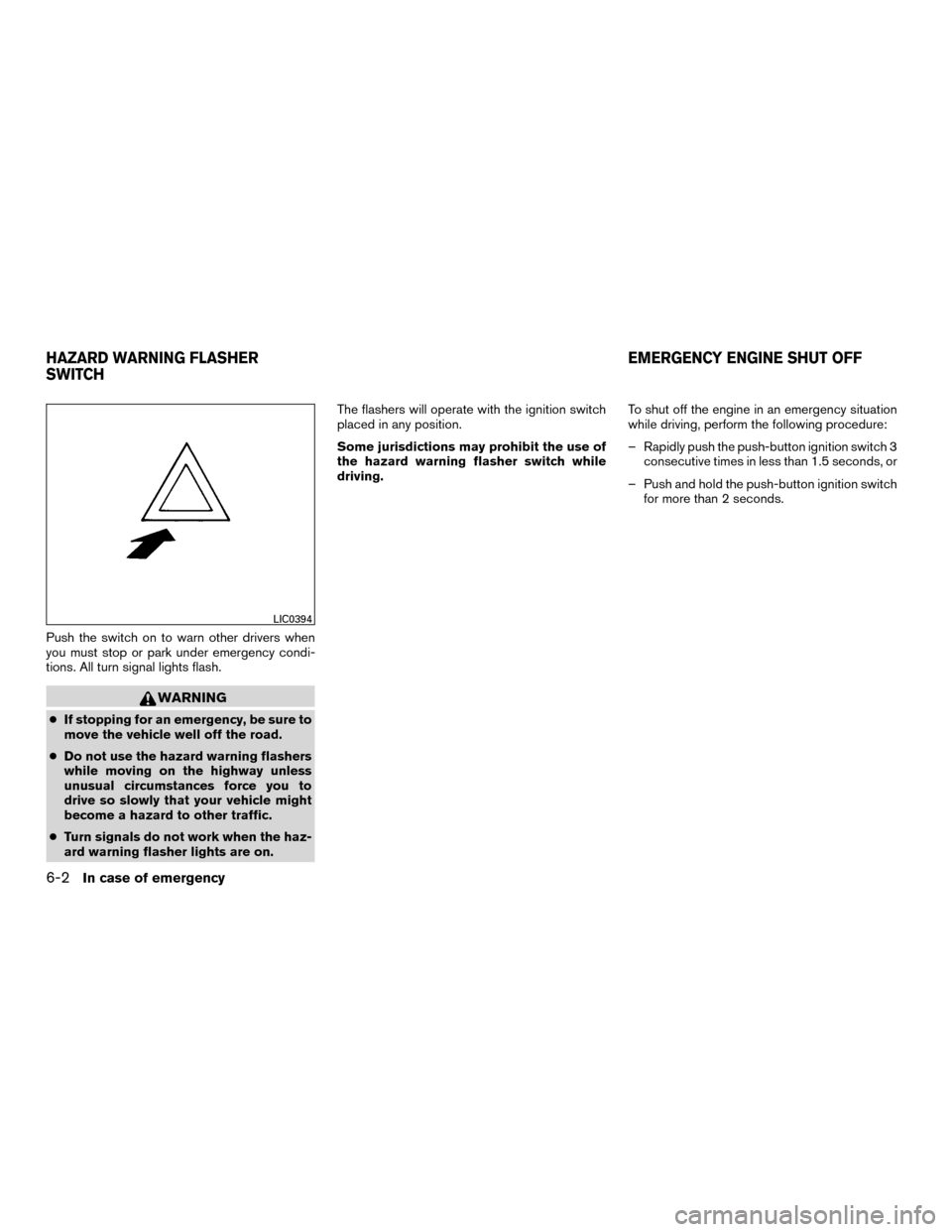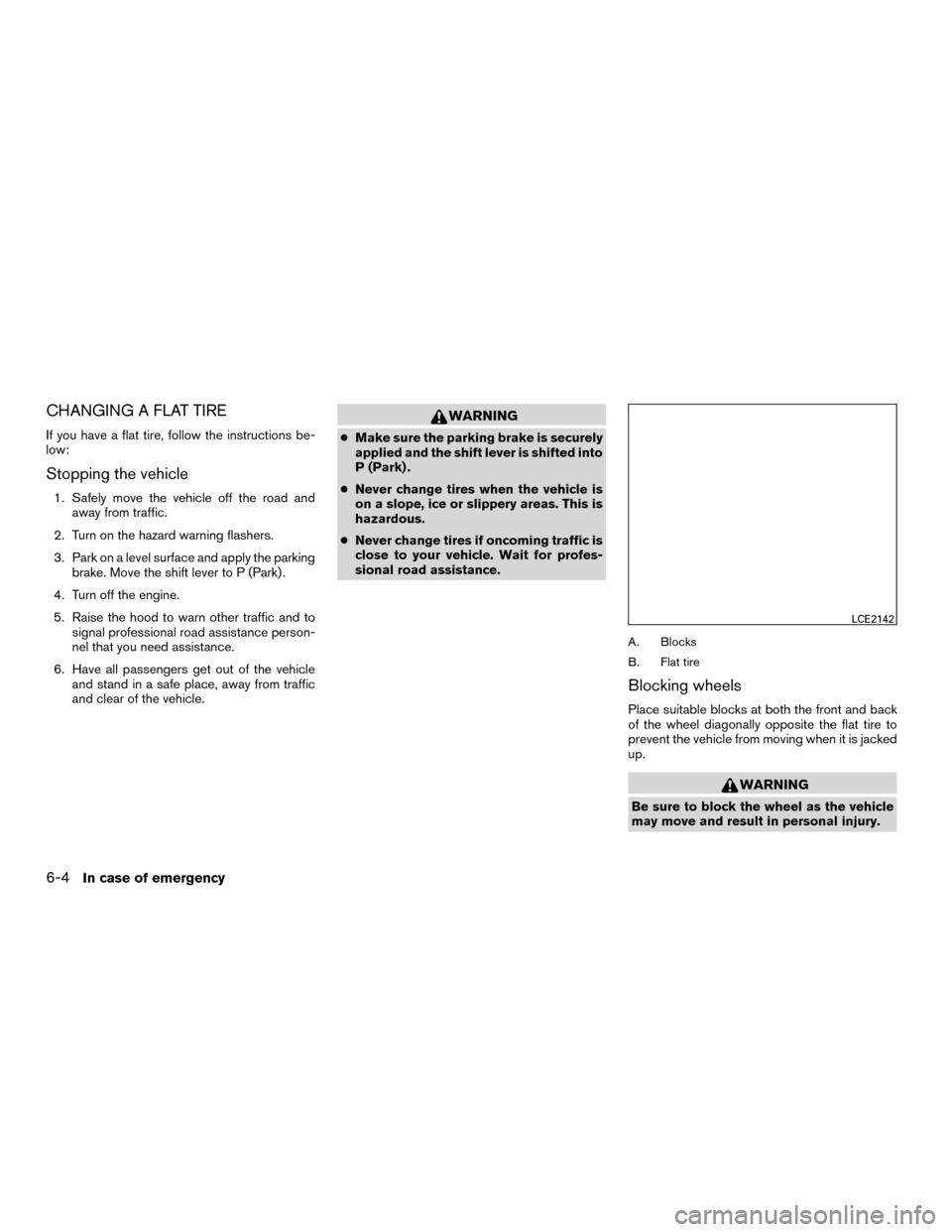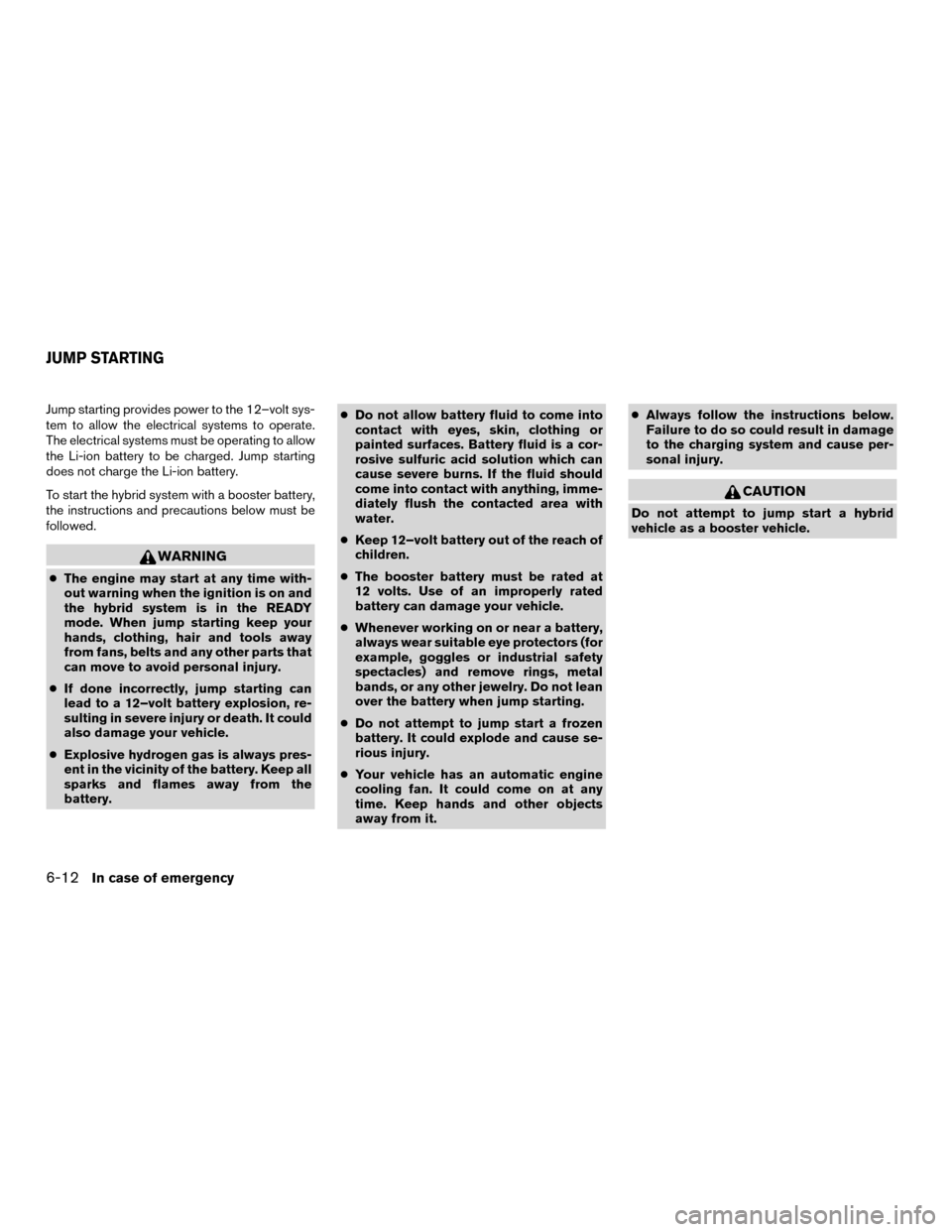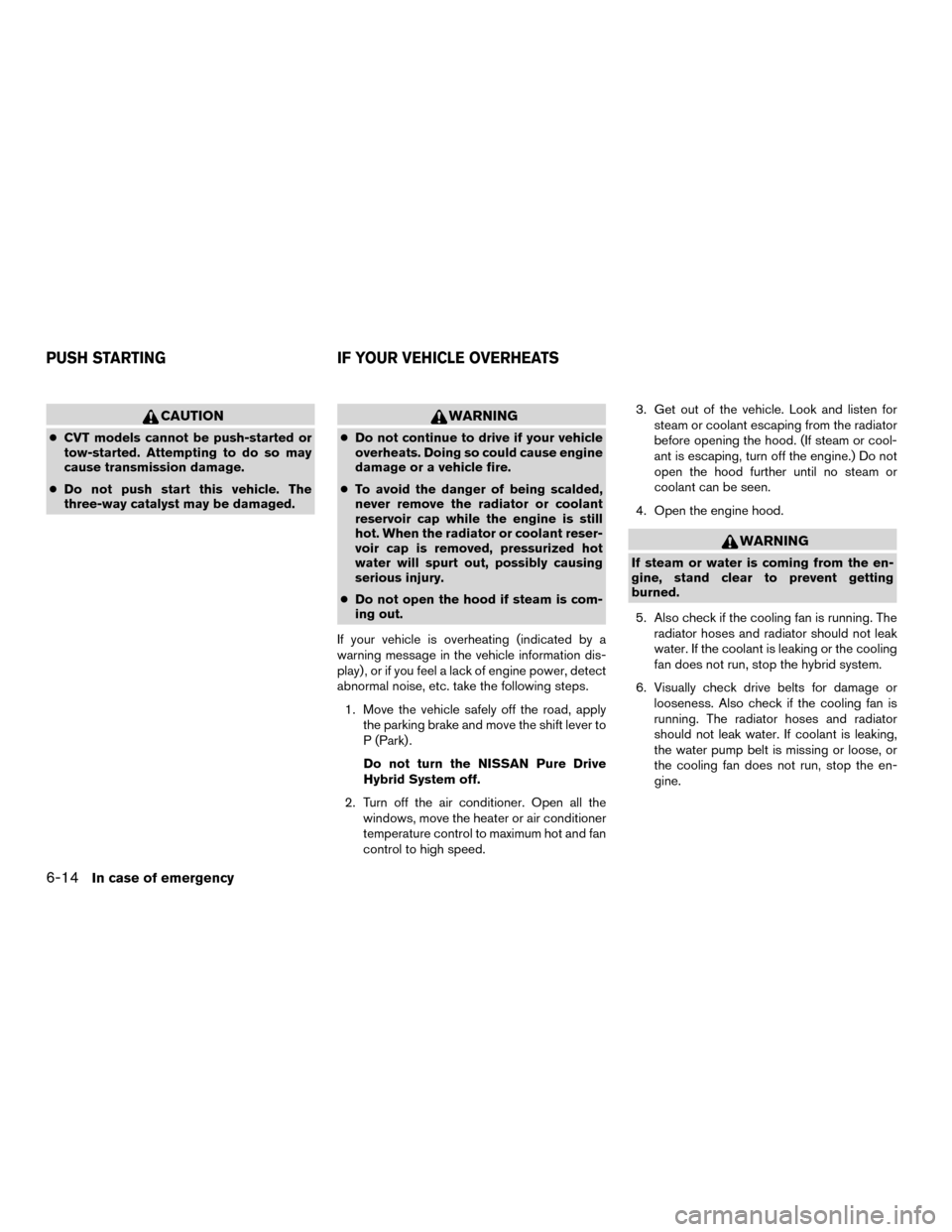Page 319 of 443

●Allow more stopping distance under
these conditions. Braking should be
started sooner than on dry pavement.
● Allow greater following distances on
slippery roads.
● Watch for slippery spots (glare ice) .
These may appear on an otherwise
clear road in shaded areas. If a patch of
ice is seen ahead, brake before reach-
ing it. Try not to brake while on the ice,
and avoid any sudden steering
maneuvers.
● Do not use the cruise control on slip-
pery roads.
● Snow can trap dangerous exhaust
gases under your vehicle. Keep snow
clear of the exhaust pipe and from
around your vehicle. This system uses microphones
�1located inside
the vehicle to detect engine booming noise. The
system then automatically generates a noise can-
celling sound through the speakers and woofer (if
so equipped) to reduce engine booming noise.
NOTE:
To operate the active noise cancellation
system properly:
● Do not cover the speakers or woofer (if so
equipped) .
● Do not cover the microphones.
Front Microphone
LSD2157
Rear Microphone
LSD2602
ACTIVE NOISE CANCELLATION
5-90Starting and driving
Page 322 of 443
6 In case of emergency
Hazard warning flasher switch......................6-2
Emergency engine shut off .........................6-2
Flat tire ...........................................6-3
Tire Pressure Monitoring System (TPMS) ..........6-3
Changing a flat tire .............................6-4
Hybrid system stops operating while driving .........6-10
If the vehicle does not start ........................6-11
Confirm battery is discharged . . .................6-11Emergency Start
.............................. 6-11
Jump starting .................................... 6-12
Push starting ..................................... 6-14
If your vehicle overheats ........................... 6-14
Towing your vehicle ............................... 6-15
Towing recommended by NISSAN ..............6-15
Vehicle recovery (freeing a stuck vehicle) .........6-17
Page 323 of 443

Push the switch on to warn other drivers when
you must stop or park under emergency condi-
tions. All turn signal lights flash.
WARNING
●If stopping for an emergency, be sure to
move the vehicle well off the road.
● Do not use the hazard warning flashers
while moving on the highway unless
unusual circumstances force you to
drive so slowly that your vehicle might
become a hazard to other traffic.
● Turn signals do not work when the haz-
ard warning flasher lights are on. The flashers will operate with the ignition switch
placed in any position.
Some jurisdictions may prohibit the use of
the hazard warning flasher switch while
driving.
To shut off the engine in an emergency situation
while driving, perform the following procedure:
– Rapidly push the push-button ignition switch 3
consecutive times in less than 1.5 seconds, or
– Push and hold the push-button ignition switch for more than 2 seconds.
LIC0394
HAZARD WARNING FLASHER
SWITCH EMERGENCY ENGINE SHUT OFF
6-2In case of emergency
Page 325 of 443

CHANGING A FLAT TIRE
If you have a flat tire, follow the instructions be-
low:
Stopping the vehicle
1. Safely move the vehicle off the road andaway from traffic.
2. Turn on the hazard warning flashers.
3. Park on a level surface and apply the parking brake. Move the shift lever to P (Park) .
4. Turn off the engine.
5. Raise the hood to warn other traffic and to signal professional road assistance person-
nel that you need assistance.
6. Have all passengers get out of the vehicle and stand in a safe place, away from traffic
and clear of the vehicle.
WARNING
●Make sure the parking brake is securely
applied and the shift lever is shifted into
P (Park) .
● Never change tires when the vehicle is
on a slope, ice or slippery areas. This is
hazardous.
● Never change tires if oncoming traffic is
close to your vehicle. Wait for profes-
sional road assistance.
A. Blocks
B. Flat tire
Blocking wheels
Place suitable blocks at both the front and back
of the wheel diagonally opposite the flat tire to
prevent the vehicle from moving when it is jacked
up.
WARNING
Be sure to block the wheel as the vehicle
may move and result in personal injury.
LCE2142
6-4In case of emergency
Page 329 of 443
Jacking up vehicle and removing the
damaged tire
WARNING
●Never get under the vehicle while it is
supported only by the jack. If it is nec-
essary to work under the vehicle, sup-
port it with safety stands.
● Use only the jack provided with your
vehicle to lift the vehicle. Do not use the
jack provided with your vehicle on other
vehicles. The jack is designed for lifting
only your vehicle during a tire change.
● Use the correct jack-up points. Never
use any other part of the vehicle for jack
support.
● Never jack up the vehicle more than
necessary.
● Never use blocks on or under the jack.
● Do not start or run the engine while
vehicle is on the jack. It may cause the
vehicle to move. This is especially true
for vehicles with limited slip
differentials.
● Do not allow passengers to stay in the
vehicle while it is on the jack. ●
Never run the engine with a wheel(s) off
the ground. It may cause the vehicle to
move.
6-8In case of emergency
Page 333 of 443

Jump starting provides power to the 12–volt sys-
tem to allow the electrical systems to operate.
The electrical systems must be operating to allow
the Li-ion battery to be charged. Jump starting
does not charge the Li-ion battery.
To start the hybrid system with a booster battery,
the instructions and precautions below must be
followed.
WARNING
●The engine may start at any time with-
out warning when the ignition is on and
the hybrid system is in the READY
mode. When jump starting keep your
hands, clothing, hair and tools away
from fans, belts and any other parts that
can move to avoid personal injury.
● If done incorrectly, jump starting can
lead to a 12–volt battery explosion, re-
sulting in severe injury or death. It could
also damage your vehicle.
● Explosive hydrogen gas is always pres-
ent in the vicinity of the battery. Keep all
sparks and flames away from the
battery. ●
Do not allow battery fluid to come into
contact with eyes, skin, clothing or
painted surfaces. Battery fluid is a cor-
rosive sulfuric acid solution which can
cause severe burns. If the fluid should
come into contact with anything, imme-
diately flush the contacted area with
water.
● Keep 12–volt battery out of the reach of
children.
● The booster battery must be rated at
12 volts. Use of an improperly rated
battery can damage your vehicle.
● Whenever working on or near a battery,
always wear suitable eye protectors (for
example, goggles or industrial safety
spectacles) and remove rings, metal
bands, or any other jewelry. Do not lean
over the battery when jump starting.
● Do not attempt to jump start a frozen
battery. It could explode and cause se-
rious injury.
● Your vehicle has an automatic engine
cooling fan. It could come on at any
time. Keep hands and other objects
away from it. ●
Always follow the instructions below.
Failure to do so could result in damage
to the charging system and cause per-
sonal injury.
CAUTION
Do not attempt to jump start a hybrid
vehicle as a booster vehicle.
JUMP STARTING
6-12In case of emergency
Page 334 of 443

1. Locate the fusible link box behind the engineair cleaner.
2. Push the tab in and lift up
�Ato remove the
lid and expose the remote positive battery
terminal
�B.
3. If the booster battery is in another vehicle position the two vehicles to bring their bat-
teries near each other.
Do not allow the two vehicles to touch.
4. Apply the parking brake. Move the shift lever to P (Park) . Switch off all unnecessary elec-
trical systems (lights, heater, air conditioner,
etc.) . 5. Ensure vent caps are level and tight.
6. Connect jumper cables in the sequence il-
lustrated (
�B,�C,�D,�E).
CAUTION
●Always connect positive (�) to positive
(�) and negative (�) to body ground (for
example, strut mounting bolt, engine
lift bracket, etc.) — not to the battery.
● Make sure the jumper cables do not
touch moving parts in the engine com-
partment and that the cable clamps do
not contact any other metal. ●
Do not keep the starter motor engaged
for more than 10 seconds. If the engine
does not start right away, place the ig-
nition switch in the OFF position and
wait 10 seconds.
7. Start the engine of the booster vehicle and let it run for a few minutes.
8. Hold down the brake pedal and press the START button. The vehicle instruments and
gauges will light up, and the green �READY�
light will come ON.
CAUTION
If the green READY light does not come
on, press the START button to turn the
hybrid system OFF. Carefully disconnect
the negative cable then the positive cable.
Have vehicle taken to dealership for
repair.
9. After the green READY light in the meter display comes ON, carefully disconnect the
negative cable and then the positive cable.LCE2170
In case of emergency6-13
Page 335 of 443

CAUTION
●CVT models cannot be push-started or
tow-started. Attempting to do so may
cause transmission damage.
● Do not push start this vehicle. The
three-way catalyst may be damaged.
WARNING
●Do not continue to drive if your vehicle
overheats. Doing so could cause engine
damage or a vehicle fire.
● To avoid the danger of being scalded,
never remove the radiator or coolant
reservoir cap while the engine is still
hot. When the radiator or coolant reser-
voir cap is removed, pressurized hot
water will spurt out, possibly causing
serious injury.
● Do not open the hood if steam is com-
ing out.
If your vehicle is overheating (indicated by a
warning message in the vehicle information dis-
play) , or if you feel a lack of engine power, detect
abnormal noise, etc. take the following steps. 1. Move the vehicle safely off the road, apply the parking brake and move the shift lever to
P (Park) .
Do not turn the NISSAN Pure Drive
Hybrid System off.
2. Turn off the air conditioner. Open all the windows, move the heater or air conditioner
temperature control to maximum hot and fan
control to high speed. 3. Get out of the vehicle. Look and listen for
steam or coolant escaping from the radiator
before opening the hood. (If steam or cool-
ant is escaping, turn off the engine.) Do not
open the hood further until no steam or
coolant can be seen.
4. Open the engine hood.
WARNING
If steam or water is coming from the en-
gine, stand clear to prevent getting
burned.
5. Also check if the cooling fan is running. The radiator hoses and radiator should not leak
water. If the coolant is leaking or the cooling
fan does not run, stop the hybrid system.
6. Visually check drive belts for damage or looseness. Also check if the cooling fan is
running. The radiator hoses and radiator
should not leak water. If coolant is leaking,
the water pump belt is missing or loose, or
the cooling fan does not run, stop the en-
gine.
PUSH STARTING IF YOUR VEHICLE OVERHEATS
6-14In case of emergency